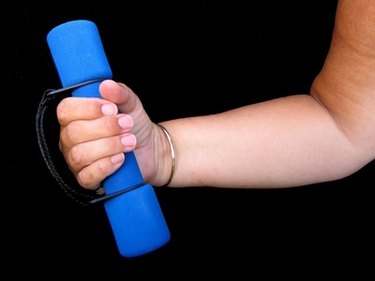
The bicep muscle runs from the shoulder to the elbow on the front of the upper arm and is responsible for bending your elbow. The muscle attaches to the bone at two points, one at the shoulder and one right below the elbow on the radius bone in the forearm. When there is a tear in that second tendon, it is referred to as a distal bicep tendon tear. This injury is most common in men who lift too much weight too suddenly. Depending on the severity of the tear and the age of the patient, it can be treated surgically or non-surgically. Either way, the injured arm will have to be immobilized for some time. Because the muscle will atrophy, regaining muscle strength can take several months. Your doctor or physical therapist will guide you through exercises and stretches that are appropriate for your degree of tendon injury and course of treatment.
Elbow Range of Motion
Video of the Day
One of the primary goals of rehabilitation after a distal bicep tendon tear is to regain range of motion of the elbow. During the first week and up to about the third week, range of motion exercises will be performed in the brace. The brace itself will be used for passive range of motion. The degree of elbow flexion and extension will be set by your therapist. As you heal, full range of motion will be the goal and you may use an upper body ergometer, a cycle for the upper body, for warm-up prior to your other exercises and has a way to gain strength.
Video of the Day
Grip Strengthening
The muscles of the forearm and the bicep all work together at the elbow. Using putty can strengthen your grip. Squeeze the putty, working your way up to 10 minutes, three times a day. Putty comes in different colors to indicate different thicknesses/strengths. Improving your grip will help in activities such as opening jars and holding utensils, your coffee cup or any weighted object. This exercise will not be added to your program until about three to four weeks post injury or surgery.
Pronation/Supination
The distal tendon of the bicep attaches to the radius bone and the muscle is one of the muscles used to pronate and supinate the forearm. Supination is turning the palm from face down to face up. Pronation is turning the palm from face up to face down. A good trick to remember the difference is your hand is supinated when you hold a bowl of soup. This exercise will be performed slowly and in a brace early on in your rehabilitation with very gradual progression to resistance bands and weights. These motions are important for turning door knobs or keys in locks.
Is this an emergency? If you are experiencing serious medical symptoms, please see the National Library of Medicine’s list of signs you need emergency medical attention or call 911.